Mastering PyTorch Loss Functions: The Complete How-To
Unlock the secrets of PyTorch loss functions with our comprehensive tutorial and improve your model's performance today. | ProjectPro

Welcome to the world of PyTorch Loss Functions, where data science meets the art of optimization! Whether you are a newbie or an experienced professional, read this blog to learn how PyTorch loss functions can help you build and optimize your machine learning models in no time.
PyTorch Project to Build a LSTM Text Classification Model
Downloadable solution code | Explanatory videos | Tech Support
Start ProjectImagine you are a data scientist working on a project to detect fraudulent transactions from a vast financial dataset using a model that can accurately identify these anomalies. But how do you measure the model's performance and optimize it? This is where PyTorch loss functions come into play! They are powerful tools that enable you to assess and minimize errors in your machine-learning models. As a data scientist, understanding the complex workings of PyTorch loss functions is like having a superpower for building robust machine learning models. It's the secret sauce that empowers you to fine-tune your ML models, optimize their performance, and achieve remarkable outcomes. From exploring the benefits of learning them to explaining how to implement them, this blog is your ultimate guide to PyTorch Loss Functions.
So, get ready to elevate your data science game and unlock the power of PyTorch loss functions!

Table of Contents
- What Are PyTorch Loss Functions?
- Why Data Scientists Must Learn About PyTorch Loss Functions?
- How To Use PyTorch Loss Functions?
- Popular PyTorch Activation Functions
- PyTorch Classification Loss Functions
- PyTorch Regression Loss Functions
- PyTorch Custom Loss Functions
- PyTorch Geometric Loss Functions
- PyTorch Combine Loss Functions
- PyTorch Lightning Multiple Loss Functions
- Exploring Loss Functions: PyTorch Projects For Practical Learning
- Build Expertise in PyTorch Loss Functions With ProjectPro
- FAQs On PyTorch Loss Functions
What Are PyTorch Loss Functions?
PyTorch loss functions are mathematical tools used in deep learning to measure the difference between predicted and target values. Whether it's image classification, natural language processing, or recommender systems, PyTorch loss functions measure how well the model performs and help optimize its parameters to achieve desired results in various real-world applications. The PyTorch nn loss functions include Binary Cross Entropy (BCELoss), Mean Squared Error (MSELoss), Cross-Entropy Loss (CrossEntropyLoss), etc.
Imagine a scenario where you are building an autonomous vehicle's object detection system. Using PyTorch loss functions, you can assess how accurate your model's predictions are compared to the ground truth labels. These loss functions, such as cross-entropy or mean squared error, measure the model's performance during training. By minimizing the loss, you enable the model to learn and enhance its ability to detect objects accurately, ensuring the safety and reliability of the autonomous vehicle system.
Before you learn how to implement PyTorch nn loss functions, it’s essential to understand the benefits of learning about PyTorch loss functions for data scientists.
Why Data Scientists Must Learn About PyTorch Loss Functions?
Understanding PyTorch loss functions is essential for data scientists, providing them with valuable tools to enhance model performance, customize solutions, and leverage them in various real-world applications. By mastering these functions, data scientists can optimize their models, achieve accurate predictions, and deliver significant outcomes across multiple industries. Let us understand the various benefits of learning PyTorch loss functions for data scientists-
-
Model Performance Optimization- PyTorch loss functions enable data scientists to optimize the performance of their deep learning models. Data scientists can improve accuracy, reduce errors, and enhance overall model performance by selecting the appropriate loss function for specific tasks such as image classification, object detection, or sentiment analysis. For instance, using PyTorch loss functions, data scientists can train models to detect fraudulent transactions accurately. Selecting a suitable loss function, such as binary cross-entropy, helps minimize false positives and negatives, enhancing the model's ability to detect fraudulent activities effectively.
-
Customization and Flexibility- PyTorch offers a wide range of pre-defined loss functions, but it also allows data scientists to create custom loss functions tailored to their specific use cases. This flexibility enables the adaptation of loss functions to unique requirements, providing more control and precision in model training. For instance, data scientists working on medical diagnosis can create custom loss functions in PyTorch to consider the specific requirements of diagnosing diseases. A custom loss function can easily prioritize false negatives over false positives to minimize the risk of missing critical diagnoses, ensuring patient safety.
Now that you have a basic understanding of PyTorch loss functions and the benefits of learning more about them, here’s a brief tutorial on how to implement them for a binary classification task.
Here's what valued users are saying about ProjectPro

Abhinav Agarwal
Graduate Student at Northwestern University

Ameeruddin Mohammed
ETL (Abintio) developer at IBM
Not sure what you are looking for?
View All ProjectsHow To Use PyTorch Loss Functions?
This section will give you a step-by-step explanation of a PyTorch loss functions example of binary classification.
1. Importing Libraries And Modules
In this step, you will import the necessary libraries and modules to work with PyTorch and perform binary classification tasks. This will include importing the torch library for PyTorch functionalities, torch.optim for optimization algorithms, torch.nn for neural network components, and other libraries for dataset generation and preprocessing.
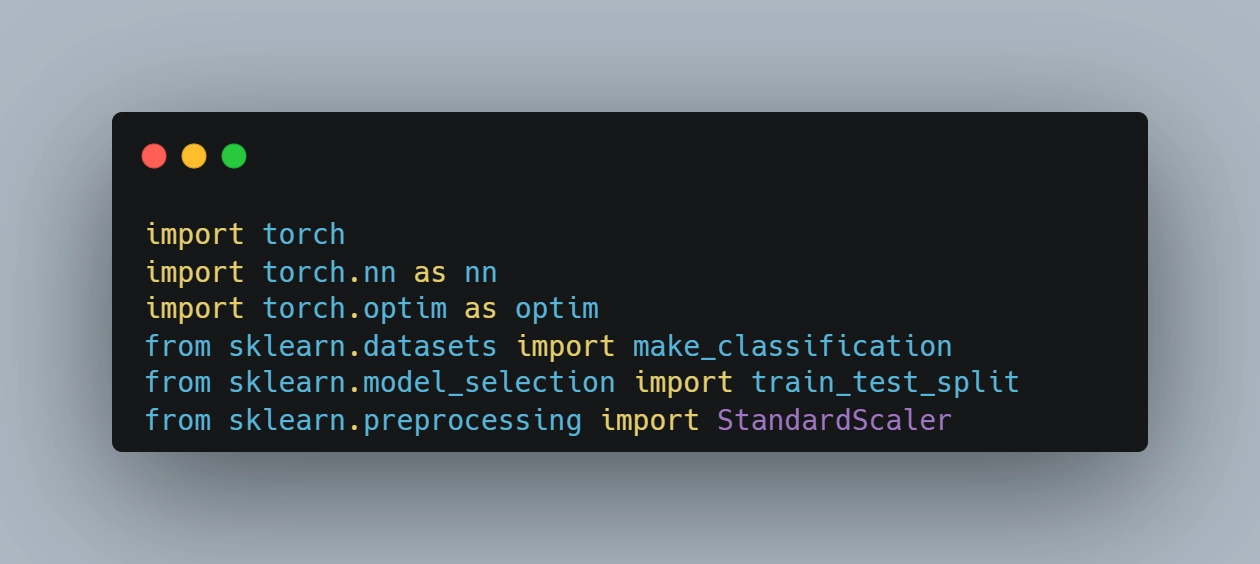
2. Dataset Generation
The second step involves generating a synthetic binary classification dataset using the make_classification function from sklearn.datasets module. This function allows you to create a dataset with a specified number of samples, features, informative features, classes, and random states. You will use the generated dataset for training and testing the binary classifier.
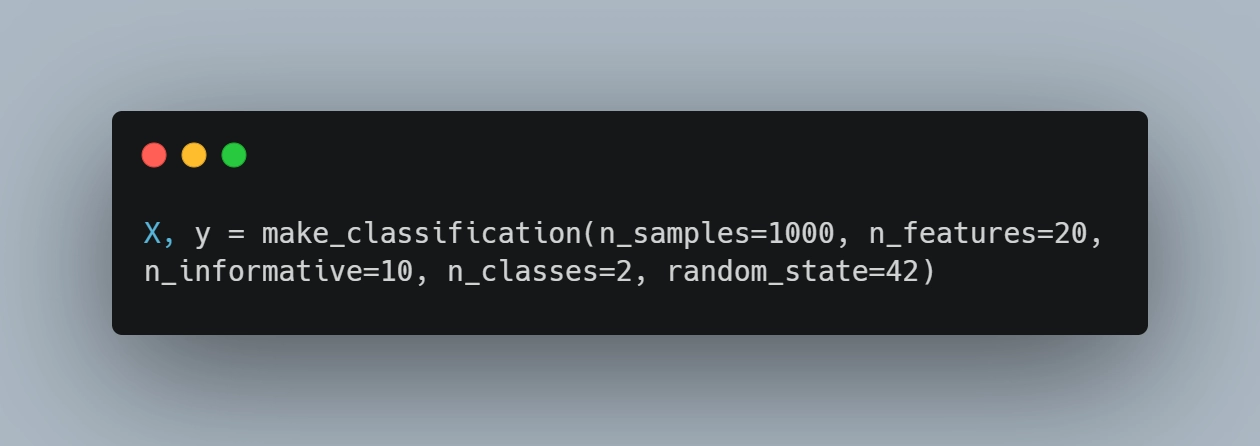
3. Data Preprocessing
Preprocessing the data is often necessary before feeding the input to the model. In this step, you will use the StandardScaler class from the ‘sklearn.preprocessing’ module to apply feature scaling to the dataset. Feature scaling helps ensure that all features are on a similar scale, preventing any feature from overtaking the learning process.
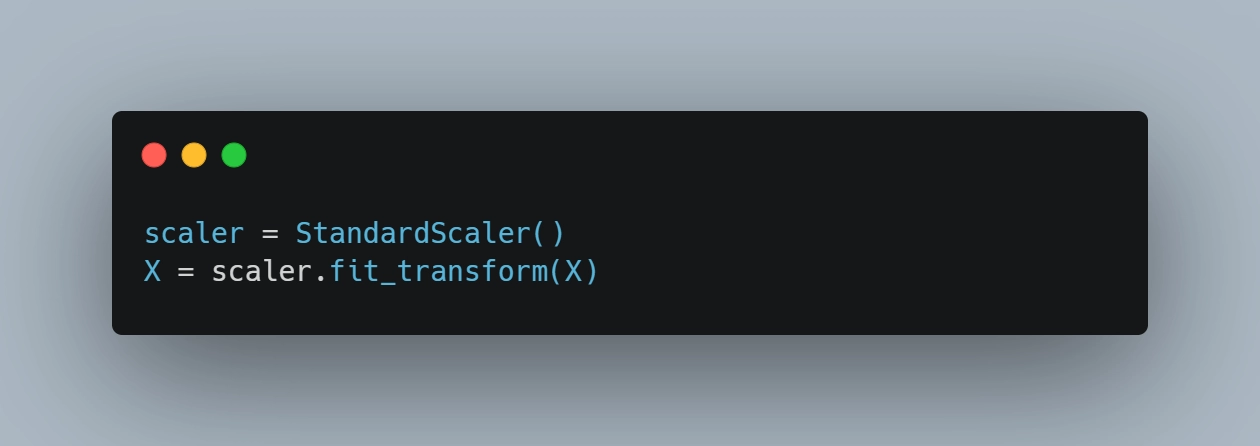
New Projects
4. Splitting The Dataset
You must split the dataset into training and testing sets to assess the model's performance. You will split the dataset into training and testing subsets using the train_test_split function from the ‘sklearn.model_selection’ package. You can specify the test size to determine the proportion of data allocated for testing.
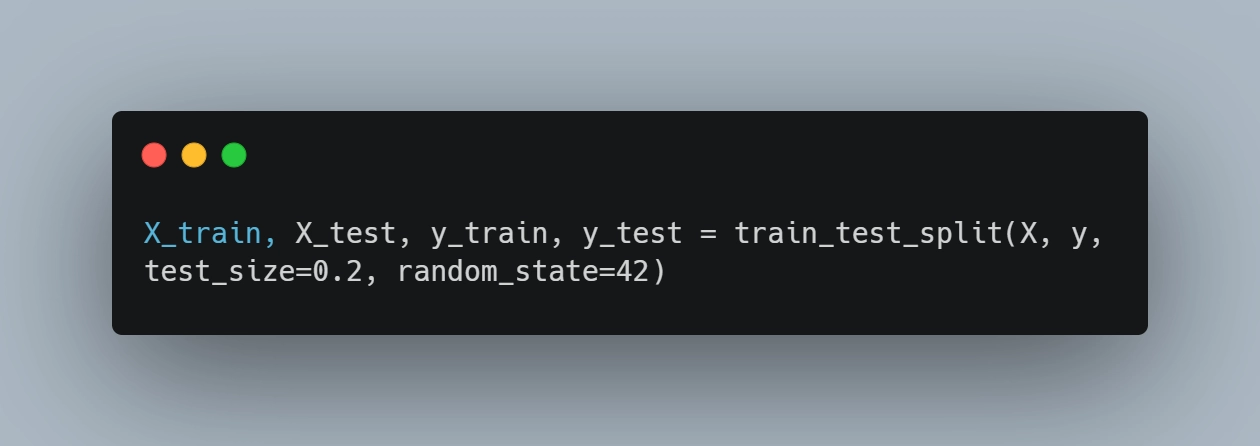
5. Defining The Model Architecture
You will specify the architecture of the binary classification model in this step. You will create a custom class called ‘BinaryClassifier’ that extends the ‘nn.Module’ class from PyTorch, inside which you will define the layers of the neural network. To produce the binary classification output in this example, you will first have a single linear layer (nn.Linear), followed by a sigmoid activation function (nn.Sigmoid).
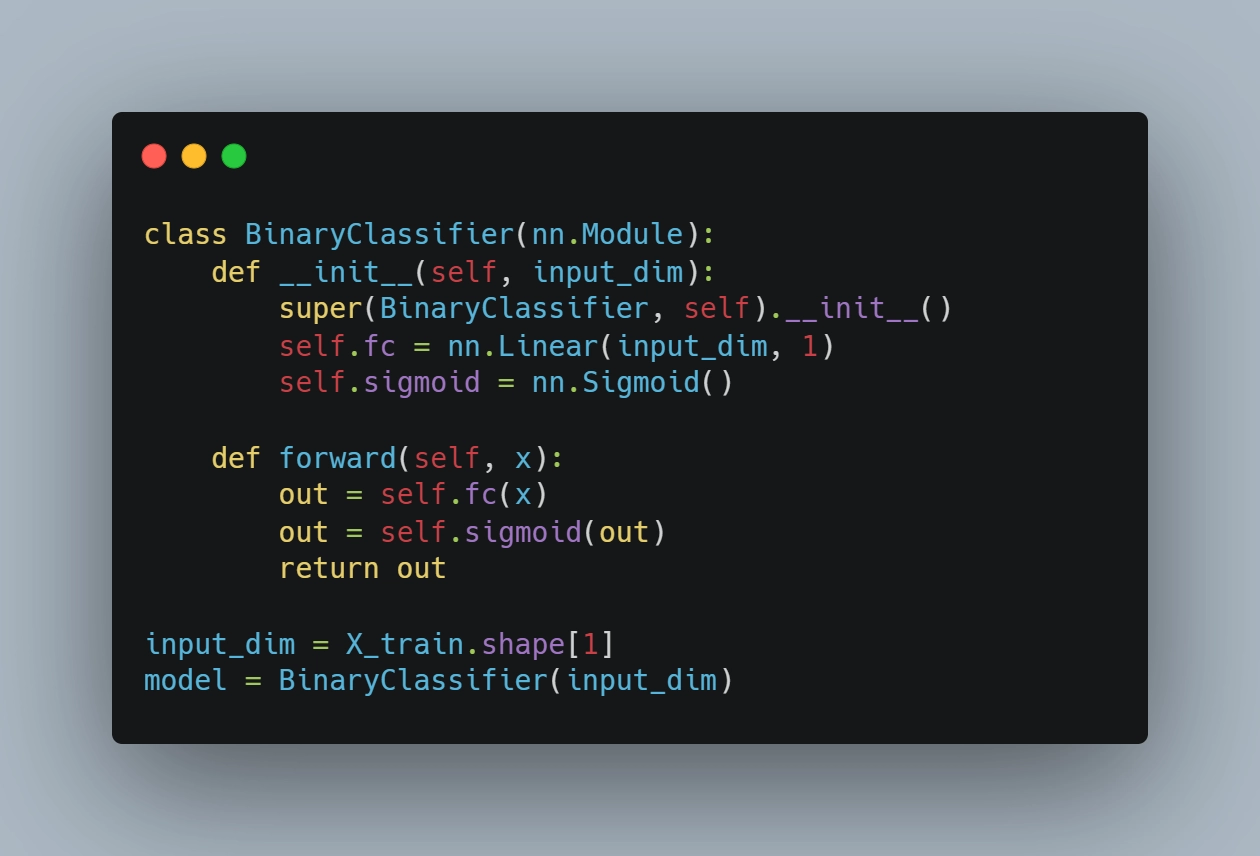
6. Defining The Loss Function And Optimizer
You must define the loss function and optimizer before training the binary classifier. In this step, you will define the loss function using the ‘nn.BCELoss()’ class, which is the Binary Cross Entropy loss function often used for binary classification tasks. Additionally, you will use PyTorch's ‘optim.Adam’ class, which implements the Adam optimization technique, to specify the optimizer.

7. Model Training
The final step involves training the model using the defined loss function and optimizer. The number of times the whole dataset is passed through the model will depend on how many epochs you iterate through. You must split the training data into mini-batches of specific batch sizes for each epoch.

You will perform the following steps for each mini-batch-
-
Forward pass the input through the model,
-
Compute the loss using the specified loss function,
-
Carry out backward propagation to add gradients using the PyTorch ‘loss backward’ function,
-
Convert the input data and labels to PyTorch tensors,
-
Zero the gradients in the optimizer,
-
Forward pass the input through the model, and
-
Update the model parameters using the optimizer.
You will determine the average loss and print it as the epoch loss at the end of each one.
With this example, you have understood the implementation of PyTorch loss functions in a binary classification task, i.e., how to train a model for binary classification and optimize it toward minimizing the loss. Let us now explore some of the popular PyTorch activation functions and PyTorch classification and regression loss functions you can use while working with various data science problems.
Looking for end to end solved data science projects? Check out ProjectPro's repository of solved Data Science Projects with Source Code!
Popular PyTorch Activation Functions
PyTorch activation functions play a critical role in deep learning models, introducing non-linearity and enabling complex pattern learning. ReLU, Sigmoid, and Leaky ReLU are among the popular activation functions in PyTorch. Understanding these activation functions and their significant features enables data scientists to make informed decisions in designing and training neural networks, thus leading to more accurate and robust models.
1. ReLU Activation Function
The Rectified Linear Unit (ReLU) is a popular activation function in PyTorch that is defined as f(x) = max(0, x), where x is the input. The ReLU function is computationally efficient and has a gradient of 1 for positive inputs, making it easier to optimize. You can use the ReLU activation function for image classification, effectively capturing and amplifying essential image features while ignoring noise or irrelevant information. For example, in a convolutional neural network (CNN) used for image recognition, the ReLU activation function is usually applied after convolutional layers that help extract significant visual features.
2. Sigmoid Activation Function
The Sigmoid activation function, also known as the logistic function, is another popular PyTorch activation function that is defined as f(x) = 1 / (1 + exp(-x)), where x is the input. The Sigmoid activation function maps the input to a range between 0 and 1, making it ideal for binary classification tasks. A common application of the Sigmoid function is sentiment analysis, which aims to determine a given text's sentiment (positive or negative). Applying the Sigmoid function to the model's output will give you a probability score indicating the sentiment polarity, allowing you to decide based on threshold values.
3. Hyperbolic Tangent (Tanh) Activation Function
The Tanh (hyperbolic tangent) activation function is a widely used PyTorch activation function, defined as f(x) = (exp(x) - exp(-x)) / (exp(x) + exp(-x)), where x is the input. The Tanh function maps the input to a range between -1 and 1, providing stronger non-linearity than the Sigmoid function. Because of its symmetry at the origin, it may be used for tasks that require both positive and negative values. The Hyperbolic Tangent activation function can be useful for capturing the dynamic range of audio signals in speech recognition systems. The model may generate normalized predictions considering positive and negative speech pattern changes by applying Tanh activation function to the output.
4. Leaky ReLU Activation Function
The Leaky ReLU (Rectified Linear Unit) is another linear activation function commonly used in PyTorch. When using a leaky ReLU, a little slope is added for negative input values, enabling a small gradient to get through during backpropagation. It is expressed as f(x) = max(0.01x, x), where x is the input. Leaky ReLU has several useful applications, including object recognition tasks in computer vision, where it helps capture both positive and negative features. Leaky ReLU can increase the learning capacity of deep neural networks and boost model performance by supporting a small gradient for negative values.
5. Scaled Exponential Linear Unit (SeLU) Activation Function
Scaled Exponential Linear Unit (SeLU) is a self-normalizing linear activation function that helps address the vanishing/exploding gradients problem. This linear activation function performs well in deep neural networks by preserving the mean and variance of input activations. The Scaled Exponential Linear Unit (SeLU) activation function can be used in speech emotion recognition systems. Applying the Scaled Exponential Linear Unit (SeLU) activation function in the deep learning model helps capture the complex patterns in speech signals, enabling more accurate emotion classification.
6. Exponential Linear Unit (ELU) Activation Function
ELU is an exponential activation function that combines the benefits of ReLU and smooth activation functions. The Exponential Linear Unit activation function has negative values for negative inputs, which helps prevent dead neurons and enables the network to learn robust representations. The Exponential Linear Unit (ELU) activation function is suitable for anomaly detection in network traffic analysis. Using ELU in a deep learning model allows the detection of unusual patterns in network traffic, helping identify potential security threats.
7. Gaussian Error Linear Unit (GELU) Activation Function
Gaussian Error Linear Unit activation function approximates the Gaussian cumulative distribution function. It has gained popularity in transformer-based models and provides a smooth non-linearity to the network. The Gaussian Error Linear Unit activation function is useful in machine translation tasks. One applies the Gaussian Error Linear Unit (GELU) function to transformer models to improve the translation quality by capturing subtle linguistic nuances and producing more accurate translations.
8. Softsign Activation Function
Softsign is an activation function that scales the input between -1 and 1 using a smooth curve. This PyTorch activation function is computationally efficient and has continuous derivatives, making it suitable for gradient-based optimization. Softsign activation function is relevant in medical image analysis. Using the Softsign activation function in a convolutional neural network (CNN) facilitates the detection of abnormalities in medical images, aiding in early diagnosis and treatment planning.
9. Softplus Activation Function
The Softplus activation function is a smooth approximation of the ReLU function. It is similar to the ELU function but without negative values. Softplus activation function provides a non-linear exponential activation while maintaining the advantages of a smooth activation function. Softplus activation function is employed in recommendation systems. When applied to collaborative filtering models, the Softplus activation function enables the prediction of user preferences, contributing to personalized and accurate recommendations.
10. Softmax Activation Function
The PyTorch Softmax is an activation function that transforms a vector of real numbers into a probability distribution. It is widely used in multi-class classification tasks to convert model outputs into probabilities for each class. The softmax function exponentiates each input vector element and then normalizes it by dividing each element by the sum of all exponentiated values. You can easily calculate PyTorch Softmax as output = F.softmax(input, dim=1). The Softmax function is ideal for image classification, sentiment analysis, natural language processing tasks, and any other multi-class classification problem where obtaining class probabilities is necessary.
11. Swish Activation Function
The Swish activation function introduces a non-linearity while keeping most positive values intact. This activation function has a smooth gradient and is significantly used in various deep-learning applications. The Swish activation function is effective in NLP tasks such as named entity recognition. Utilizing the Swish activation function in a deep learning model helps identify and extract specific entities from text, enhancing information extraction capabilities.
The following section covers some of the useful PyTorch classification loss functions in detail and their example use cases to help you better understand these functions and their real-world applications.
PyTorch Classification Loss Functions
PyTorch offers a wide range of classification loss functions crucial for training and analyzing models in classification tasks. These loss functions offer insights into model performance by numerically measuring the difference between expected and actual class labels. Some popular PyTorch classification loss functions include Cross-Entropy Loss, Binary Cross-Entropy Loss, and Categorical Cross-Entropy Loss. Each loss function is designed for particular multi-class or binary classification tasks. For tasks like image classification, sentiment analysis, and document categorization, data scientists must understand and choose the correct classification loss function to optimize their models and make precise predictions.
Let us look at some useful PyTorch loss functions for binary classification-
1. Cross-Entropy Loss
The Cross-Entropy loss function in PyTorch is commonly used for binary and multi-class classification tasks. It measures the dissimilarity between predicted class probabilities and actual class labels. It can be defined as the negative logarithm of the predicted probability of the correct class. The lower the cross-entropy loss, the closer the predicted probabilities are to the actual labels. Furthermore, focal loss in PyTorch is a variant of the Cross-Entropy loss function that deals with the class imbalance in binary classification problems. It assigns higher weights to challenging samples, focusing on hard-to-classify examples.
A relevant use case for Cross-Entropy loss is image classification. The following code shows how to use the PyTorch Loss Functions formula to calculate Cross-Entropy loss using the CNN model and the popular CIFAR-10 dataset.

You will use the CIFAR-10 dataset and a pre-trained ResNet-18 model in this example. You will preprocess the dataset by applying transformations such as converting the images to tensors and normalizing them. You will define the CNN model and modify the fully connected layer to have the right number of output classes. During training, the model's outputs are compared with the ground truth labels using the Cross-Entropy loss function. Gradients are computed and used to update the model's parameters with the optimizer.
2. Binary Cross-Entropy Loss
The Binary Cross-Entropy loss function in PyTorch is commonly used for binary classification tasks. It measures the dissimilarity between predicted probabilities and true binary labels. It can be defined as the negative logarithm of the predicted probability for the true class in a binary classification problem. The lower the binary cross-entropy loss, the closer the predicted probabilities are to the true labels.
A relevant use case for Binary Cross-Entropy loss is sentiment analysis, which helps classify text as positive or negative sentiment. Let's consider an example of sentiment analysis using a pre-trained BERT model and the IMDB movie review dataset-

In this example, you will use the BERT model for sentiment analysis. You will first initialize the Binary Cross-Entropy loss function (criterion) and the Adam optimizer (optimizer). The model is trained on the preprocessed IMDB movie review dataset, where each review is associated with a binary sentiment label (positive or negative). During training, the model's predicted probabilities are compared with the true labels, and the Binary Cross-Entropy loss is calculated. The gradients are then computed to update the model's parameters via the optimizer.
By minimizing the difference between estimated probabilities and the actual probability distribution of binary labels, Binary Cross-Entropy loss allows the model to learn how to classify the sentiment of the given text.
3. Categorical Cross-Entropy Loss
The PyTorch Categorical Cross-Entropy loss function is commonly used for multi-class classification tasks with more than two classes. It measures the dissimilarity between predicted class probabilities and true class labels. It can be defined as the negative logarithm of the expected probability of the true class.
Let us consider a text classification task where you must categorize news articles into different topics such as sports, politics, and entertainment. Using the Categorical Cross-Entropy loss, the model can learn to accurately assign the right category to each news article by minimizing the dissimilarity between predicted class probabilities and the true class labels.
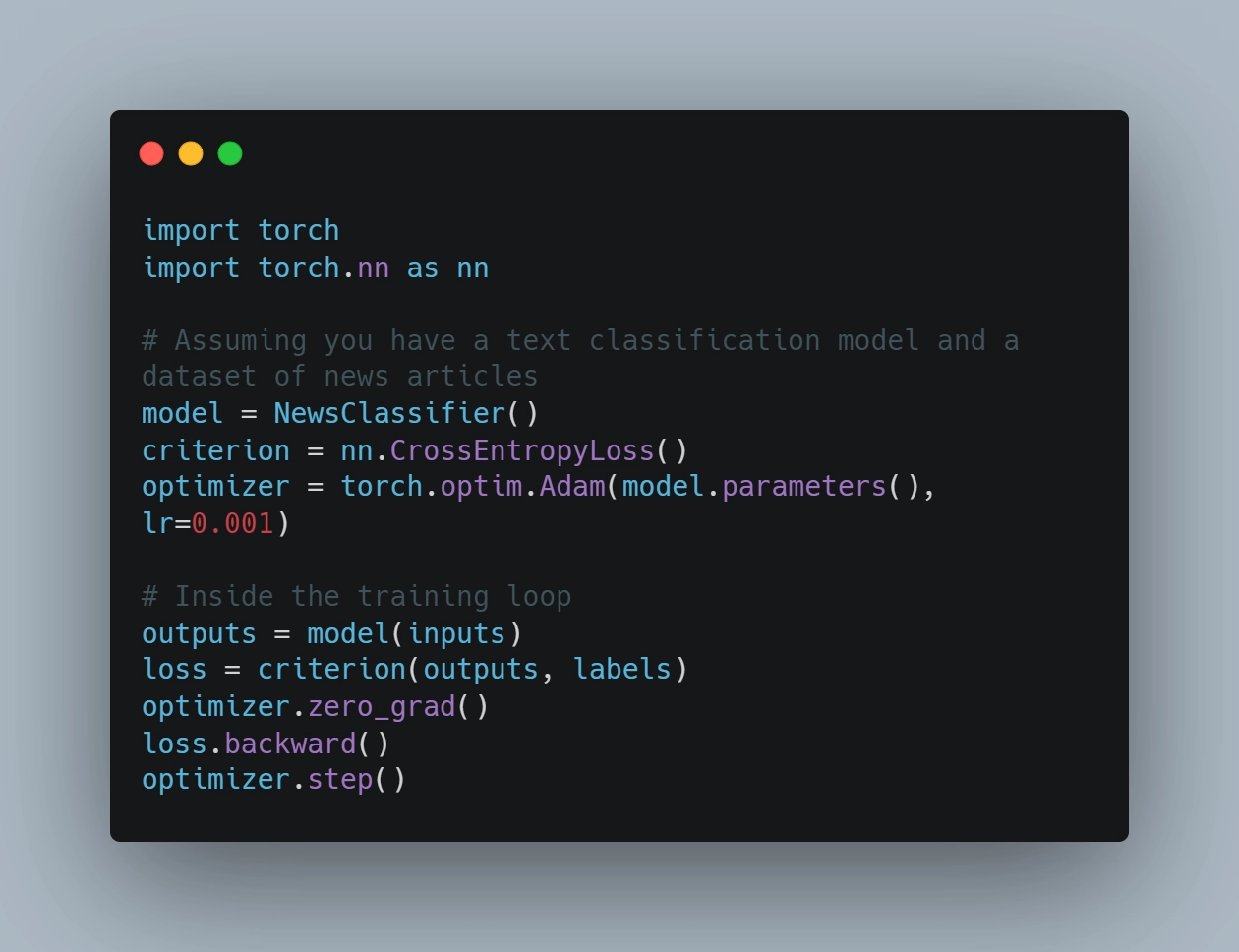
In this example use case, the 'model' represents the neural network model designed explicitly for news article classification, the 'criterion' is initialized as the Categorical Cross-Entropy loss function, and the 'optimizer' is the optimization algorithm. The model's predictions ('outputs') are compared with the true class labels ('labels'), and the Categorical Cross-Entropy loss is computed. By backpropagating the loss and optimizing the model's parameters, the model can effectively classify news articles into their respective topics.
The following section covers some of the useful PyTorch regression loss functions in detail, and their example use cases to help you better understand these functions and their real-world applications.
PyTorch Regression Loss Functions
PyTorch regression loss functions are essential components for training models in regression tasks. These loss functions measure the variations between predicted and actual continuous values, allowing data scientists to optimize model parameters. Popular PyTorch Loss Functions For Regression include Mean Squared Error, Mean Absolute Error, and Huber Loss. Each of these loss functions is useful for specific regression scenarios, offering different ways to measure the error and support the model's learning process.
1. Mean Squared Error (MSE) Loss
The PyTorch loss function ‘MSE’, or Mean Squared Error, is popularly used in regression tasks to determine the average squared difference between the predicted and true values. It is calculated by taking the mean of the squared differences between each prediction and its corresponding ground truth value. The lower the MSE, the closer the predicted values are to the true values.
Let us consider a relevant example for PyTorch Loss Function ‘MSE’, such as predicting housing prices. You will work with the Boston Housing dataset, which contains features related to houses in Boston, such as crime rate, the average number of rooms, and accessibility to highways, and train a Linear Regression model to estimate house prices.

In this example, you will preprocess the Boston Housing dataset by splitting it into training and testing sets and scaling the features using a StandardScaler. You will then define a Linear Regression model using the nn.Linear class. During training, the model's predictions are compared with the true house prices using the MSE loss function. Gradients are computed and used to update the model's parameters using the SGD optimizer.
Using MSE in this scenario allows the model to learn to predict house prices by minimizing the average squared difference between predicted max value and true values.
2. Mean Absolute Error (MAE) Loss
The Mean Absolute Error (MAE) is a PyTorch loss function commonly used in regression tasks. It measures the average absolute difference between the predicted and true values, making it robust to outliers. One relevant example of using MAE is in predicting the demand for a product based on historical sales data, pricing information, and promotional activities.
For instance, suppose you are a data scientist working on a demand forecasting project for an e-commerce platform. Using MAE as the loss function, you can train a regression model like the Gradient Boosting Regressor Gradient Boosting Regression model from the XGBoost library. You will work with the E-commerce Sales dataset on Kaggle, which includes features such as product attributes, pricing, and historical sales data. The model will learn to minimize the average absolute difference between predicted and actual demand quantities.

Using MAE in this context allows the model to learn patterns and accurately forecast demand, enabling the e-commerce company to optimize inventory, improve customer satisfaction, and streamline their supply chain operations.
3. Huber Loss
The Huber loss function is a PyTorch loss function commonly used in regression tasks, especially when dealing with outliers in the data. It combines Mean Absolute Error (MAE) and Mean Squared Error (MSE) using a delta value as a threshold. When the absolute difference between the predicted and true values is below the delta threshold value, it behaves like MAE; otherwise, it switches to MSE. This makes Huber loss less sensitive to outliers compared to MSE.
Let's consider an example of autonomous vehicle control where you will train a deep neural network (DNN) model to estimate the steering angle based on sensor inputs from a self-driving car. You will train the model using the Udacity Self-Driving Car dataset available on Kaggle, which includes sensor readings such as images, lidar, and steering angles.
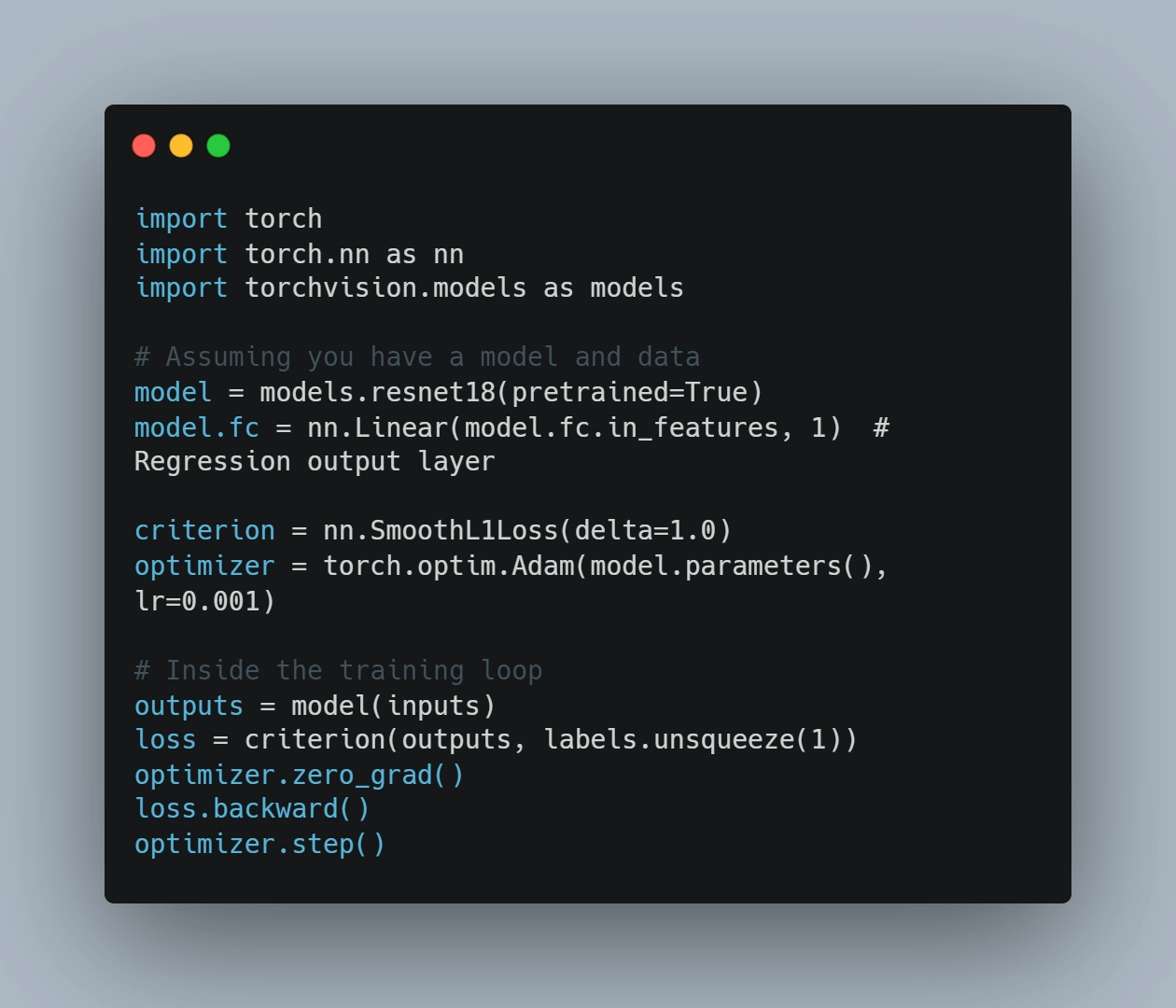
You will use the ResNet-18 architecture pre-trained on ImageNet as the backbone model in this example. You will modify the fully connected layer to have a single output neuron for regression. You will initialize the Huber loss (SmoothL1Loss) with a delta value of 1.0, and the optimizer used is Adam. During training, the model's predictions (outputs) are compared with the true steering angles (labels) after unsqueezing the dimension to match the output vector shape. The Huber loss is then calculated, gradients are computed, and the optimizer updates the model's parameters.
Using Huber loss in autonomous vehicle control allows the model to learn robustly from the data, mitigating the impact of outliers and improving trajectory estimation accuracy. Combining MAE and MSE aspects in Huber loss strikes a balance between robustness and precision, making it suitable for scenarios where outliers can significantly affect regression results.
In the following section, we will discuss PyTorch custom loss functions and their implementation with the help of an example use case to help you better understand how to leverage these custom loss functions in data science applications.
PyTorch Custom Loss Functions
PyTorch allows data scientists to create custom loss functions tailored to their specific needs. Custom loss functions are implemented as subclasses of the torch.nn.Module class, and they offer flexibility in defining complex loss functions that cannot be expressed using pre-defined loss functions.
A common use case for PyTorch Loss Functions (Custom) is anomaly detection in time series data, such as detecting abnormal patterns indicative of equipment failure in sensor readings. Let us consider a specific example of anomaly detection using a Variational Autoencoder (VAE) model on the "Numenta Anomaly Benchmark" dataset.

In this example, the CustomLoss class extends the nn.Module class and computes the loss function for anomaly detection using a VAE model. The loss function has two components: the reconstruction loss, which calculates the difference between the input and reconstructed output, and the Kullback-Leibler (KL) divergence, which encourages the learned latent space to follow a standard normal distribution. The total loss is the sum of the reconstruction loss and the KL divergence. During training, the model's outputs, latent variables (mu and logvar), and input data are passed to the custom loss function to compute the anomaly score. Gradients are then computed to update the model's parameters with the optimizer.
These data science projects with R will give you the best idea of importance of R programming language in data science. Explore them today!
PyTorch Geometric Loss Functions
PyTorch Geometric offers a comprehensive collection of Geometric Loss Functions tailored specifically for graph data. These specialized loss functions enable you to optimize and train your graph neural network models effectively. With PyTorch Geometric, you can easily calculate loss values that account for the unique characteristics of graph data, such as graph structure, edge features, or node attributes. These loss functions cater to various scenarios, such as graph classification, node classification, and link prediction.
The syntax for PyTorch Geometric loss functions is quite simple. You can directly import the desired loss function from the torch_geometric.nn.loss module. For example-
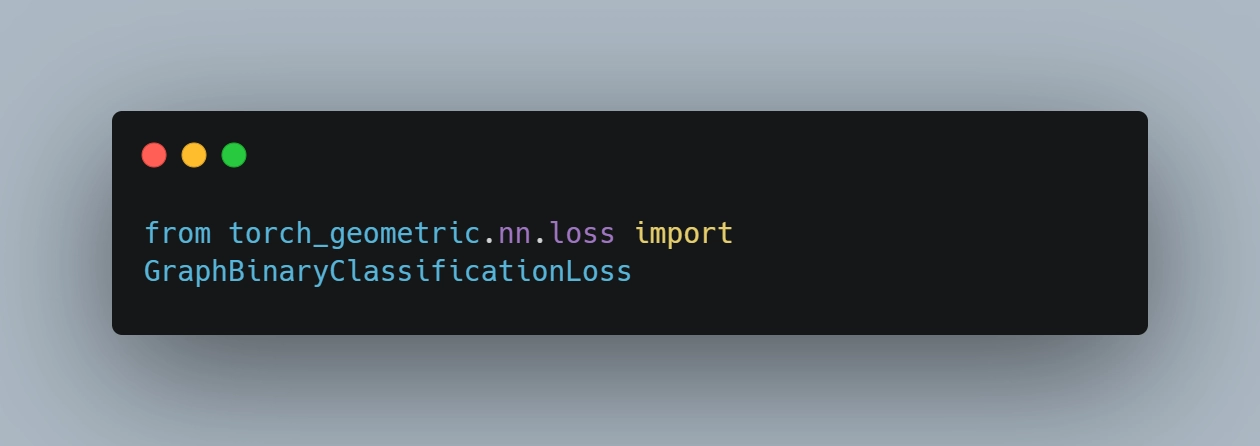
PyTorch Combine Loss Functions
PyTorch Combine Loss Functions is a powerful feature that allows data scientists to create customized loss functions by combining multiple existing loss functions. This feature enables fine-grained control over the training process and the ability to address complex optimization objectives. By combining different loss functions, you can leverage the strengths of each component and create a composite loss function based on your specific needs.
The syntax for PyTorch Combine Loss Functions involves defining a new loss function by combining existing loss functions. First, import the necessary modules and loss functions from torch.nn module, and then define a custom loss function by combining existing loss functions-

PyTorch Lightning Multiple Loss Functions
PyTorch Lightning simplifies handling multiple loss functions in a training loop with its powerful Multiple Loss Functions feature. This feature is useful when dealing with complex models that require optimizing multiple loss components simultaneously. By seamlessly integrating this feature into your workflow, these PyTorch Multiple Loss Functions allow you to effortlessly define and optimize multiple loss functions without managing individual losses. With a dictionary mapping each loss name to its respective loss function, you can handle multi-task learning, combine different loss components, or address complex optimization scenarios.
To use multiple PyTorch Lightning loss functions, you can define a dictionary that maps each loss name to its corresponding loss function. The syntax is as follows-

Now that you have gained a fundamental understanding of all the useful PyTorch loss functions, it’s time to explore some exciting and useful real-world project ideas that involve the use of PyTorch loss functions.
Exploring Loss Functions: PyTorch Projects For Practical Learning
Below are some interesting project ideas you can practice to deepen your understanding of PyTorch loss functions further before you can start using them effectively in your projects-
1. Learn to Build Generative Models Using PyTorch Autoencoders
In this unique deep learning project, you will learn how to build a Generative Model (GAN model) in PyTorch using Autoencoders on the MNIST dataset. This project will show you how to use Autoencoders as Generative Models followed by generation of new images of digits by using the Generative Model. For this project, you will leverage several PyTorch modules including torch, torchvision, torchinfo, and the Mean Square Error (MSE) PyTorch loss function to ensure that the decoder produces the image which resembles the input image.
Source Code- Learn to Build Generative Models Using PyTorch Autoencoders
2. Text Detection in Images Using Python
In this exciting project, you will build a CRNN deep learning model to predict the single-line text in a given image. You will use the TRSynth100K dataset that contains around 100k images along with their labels in a text file. In this project, you will work with PyTorch's CTC (Connectionist Temporal Classification) loss function while converting the image into a series of time-based activations. You will take the negative probabilities of all the possible sequences that can result in the true sequence and sum them all together, which will give you the CTC loss value. You will further use this
loss to backpropagate and train the model.
Source Code- Deep Learning Project for Text Detection in Images using Python
3. Build a CNN Model for Image Classification using PyTorch
In this useful machine learning project, you will build a CNN model for image classification where images will be classified into social security cards, driving licenses, and others. You will import PyTorch modules including torch and torchvision, and also leverage the ReLU PyTorch activation function and Cross-Entropy loss function as it is ideal for multi-class classification tasks. You will use the loss to backpropagate and optimize the weights and print the loss each time for ten epochs in total.
Source Code- Build a CNN Model with PyTorch for Image Classification
Build Expertise in PyTorch Loss Functions With ProjectPro
Understanding and leveraging appropriate PyTorch loss functions is crucial for data science and machine learning professionals. The right choice of the loss function can significantly impact the model's performance and optimization with the ability to solve several data science challenges effectively. As you dive into the world of PyTorch loss functions, gaining hands-on experience becomes vital.
ProjectPro offers over 270 end-to-end solved data science and machine learning projects that give you an exceptional opportunity to apply PyTorch loss functions in real-world scenarios. Working on these innovative projects can strengthen your understanding of loss functions' implementation and enhance your career prospects. Seize the chance to upskill yourself with industry-level projects from the ProjectPro repository and accelerate your career in data science and machine learning. Your journey toward becoming a proficient data scientist starts here!
Get FREE Access to Data Analytics Example Codes for Data Cleaning, Data Munging, and Data Visualization
FAQs On PyTorch Loss Functions
1. What loss function does PyTorch use?
PyTorch uses various loss functions for different tasks, including classification and regression. Some commonly used loss functions in PyTorch are Cross-Entropy Loss, Mean Squared Error (MSE) Loss, and Binary Cross-Entropy Loss.
2. How to calculate loss in PyTorch?
You can calculate loss in PyTorch by comparing the predicted values of a model with the default values of ground truth labels using a predefined or custom loss function such as Mean Squared Error (MSE) or Cross-Entropy Loss.
3. How do you maximize loss in PyTorch?
You can maximize loss in PyTorch by simply obtaining the negative value of the loss. You can do this by multiplying the loss by -1 or by using PyTorch's built-in negative loss function.
About the Author
Daivi
Daivi is a highly skilled Technical Content Analyst with over a year of experience at ProjectPro. She is passionate about exploring various technology domains and enjoys staying up-to-date with industry trends and developments. Daivi is known for her excellent research skills and ability to distill



